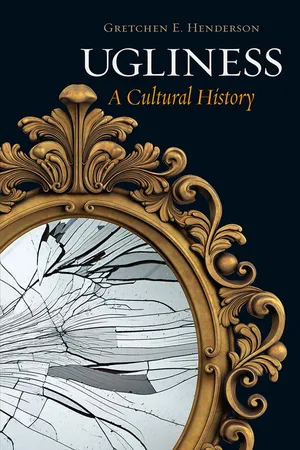
- English
- ePUB (mobile friendly)
- Available on iOS & Android
About this book
‘Ugly as sin’, ‘ugly duckling’, ‘rear its ugly head’. The word ‘ugly’ is used freely, yet it is a loaded term: from the simply plain and unsightly to the repulsive and even offensive, definitions slide all over the place. Hovering around ‘feared and dreaded’, ugliness both repels and fascinates. But the concept of ugliness has a lineage that has long haunted our cultural imagination.
In this riveting book, Gretchen E. Henderson explores perceptions of ugliness through history, from ancient Roman feasts to medieval grotesque gargoyles, from Mary Shelley’s monster cobbled from corpses to the Nazi Exhibition of Degenerate Art. Covering literature, art, music and even Uglydolls, Henderson reveals how ugliness has long posed a challenge to aesthetics and taste.
Henderson digs into the muck of ugliness, moving beyond the traditional philosophic argument or mere opposition to beauty, and emerges with more than a selection of fascinating tidbits. Following ugly bodies and dismantling ugly senses across periods and continents, Ugliness: A Cultural History draws on a wealth of fields to cross cultures and times, delineating the changing map of ugliness as it charges the public imagination. Illustrated with a range of artefacts, this book offers a refreshing perspective that moves beyond the surface to ask what ‘ugly’ truly is, even as its meaning continues to shift.
Frequently asked questions
- Essential is ideal for learners and professionals who enjoy exploring a wide range of subjects. Access the Essential Library with 800,000+ trusted titles and best-sellers across business, personal growth, and the humanities. Includes unlimited reading time and Standard Read Aloud voice.
- Complete: Perfect for advanced learners and researchers needing full, unrestricted access. Unlock 1.4M+ books across hundreds of subjects, including academic and specialized titles. The Complete Plan also includes advanced features like Premium Read Aloud and Research Assistant.
Please note we cannot support devices running on iOS 13 and Android 7 or earlier. Learn more about using the app.
Information
REFERENCES
Introduction: Pretty Ugly: A Question of Culture
1 Ugly Ones: Uncomfortable Anomalies
Table of contents
- Front Cover
- Half Title
- Title Page
- Copyright
- Contents
- Introduction: Pretty Ugly: A Question of Culture
- ONE Ugly Ones: Uncomfortable Anomalies
- TWO Ugly Groups: Resisting Classification
- THREE Ugly Senses: Transgressing Perceived Borders
- Epilogue: Ugly Us: A Cultural Quest?
- REFERENCES
- ACKNOWLEDGEMENTS
- PHOTO ACKNOWLEDGEMENTS
- INDEX